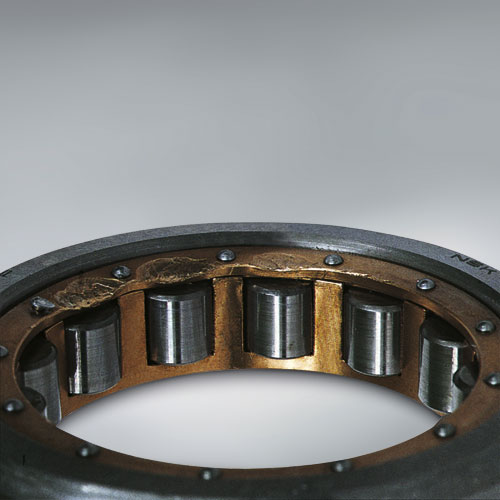Welcome to Sino Bearings web
24x7 HOTLINE:+86-28-81454188

 TECHNOLOGY
TECHNOLOGYWhen a rolling bearing is damaged during machine operation, the entire machine or equipment can seize or malfunction. Since bearings that fail prematurely or unexpectedly cause trouble, it is important to be able to identify and predict failure beforehand, so that preventive measures can be adopted.
Damage ConditionCage damage includes: Cage deformation, fracture and wear; Fracture of cage pillars; Deformation of side face; Wear of pocket surface; and Wear of guide surface.
Possible Causes Poor mounting (Bearing misalignment) Poor handling Large moment load Shock and large vibration Excessive rotation speed, sudden acceleration and deceleration Poor lubrication Temperature rise Countermeasures Check the mounting method Check the temperature, rotation and load conditions Reduce the vibration Select a different cage type Select a different lubrication method and/or lubricant Cage Damage 1Part: Cage of a deep groove ball bearing
Symptom: Fracture of pressed-steel cage pocket

Part: Cage of an angular contact ball bearing
Symptom: Pocket pillar Fractures of a cast iron machined cage
Cause: Abnormal load action on cage due to misaligned mounting between inner and outer rings
Part: Cage of an angular contact ball bearing
Symptom: Fracture of machined high-tension brass cage

Part: Cage of a tapered roller bearing
Symptom: Pillar Fractures of pressed-steel cage

Part: Cage of an angular contact ball bearing
Symptom: Pressed-steel cage deformation
Cause: Shock load due to poor handling

Part: Cage of a cylindrical roller bearing
Symptom: Deformation of the side face of machined high-tension brass cage
Cause: Large shock during mounting

Part: Cage of a cylindrical roller bearing
Symptom: Deformation and Wear of machined high-tension brass cage

Part: Cage of an angular contact ball bearing
Symptom: Stepped Wear on the outside surface and pocket surface of machined high-tension brass cage

Source: NSK